The living room is the first room that your guests see when they come visiting, which is why you should decorate it right.
But you’ll agree with me that styling your living room is easier said than done.
Fortunately, knowing some of the vital living room interior design rules can make it so much easier to create your dream space. Besides, some of these rules will answer some of the basic interior design questions you might have.
Read on and discover the eight golden rules of living room design and while at it click here to find some beautiful items for your living room.
Contents
1. The Size of the Rug
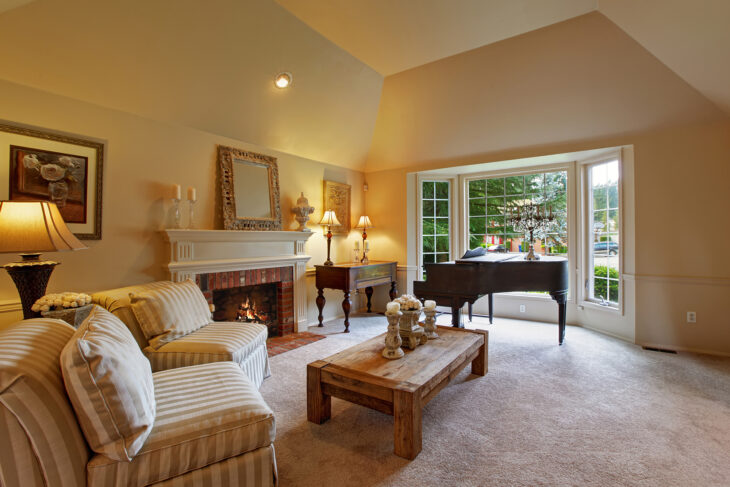
Source: apartmenttherapy.com
A beautiful rug can unify the different elements in your living room. An area rug also helps define the seating area in your room. But for your living room rug to achieve these goals, it must be appropriately sized.
Your living room rug should be large enough to allow the front legs of your couches and other upholstered pieces to rest on top of it.
Ensure your rug isn’t too big such that it looks like a wall-to-wall carpet. Such an oversized area rug doesn’t leave any breathing room in your space. Similarly, a tiny rug makes the room look out of proportion.
2. Follow the Rule of Thirds
Have you heard of the rule of thirds?
Well, if you haven’t, it’s time to learn.
The concept provides that when you arrange objects in threes, they are more pleasing to the eye. The rule is also used to divide the view of a room into a three-by-three grid to create balance.
So, when it comes to styling your living room, do it with the rule of threes in mind. For instance, you can arrange your furniture in odd numbers. Similarly, you can add a trio of items to your simple coffee table to make it stand out.
3. Hang Your Artwork Correctly
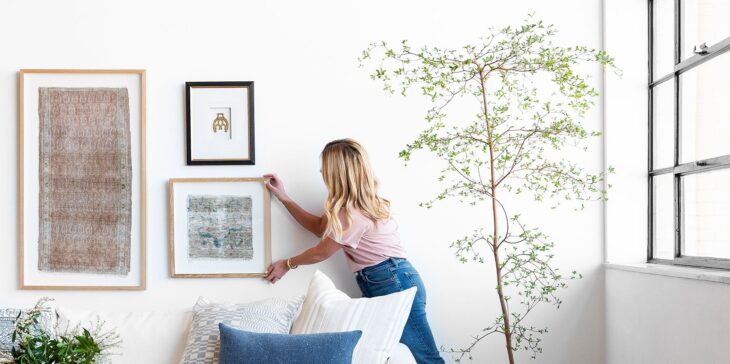
Source: studio-mcgee.com
The 57” rule will come in handy when it comes to hanging your artwork.
The rule states that when you hang your piece of art, the artwork’s center should be at eye level or 57 inches (1.45 m) from the ground. This rule also applies when you’re hanging a gallery wall. Ensure the main photo is at eye level and the other pieces are hung in relation to the main picture.
Additionally, treat each piece as one when you want to hang more than one work of art. The recommended spacing between multiple pieces of art is about 3” to 6”.
However, there are exceptions to the 57” rule, such as when you’re hanging your piece of art above the furniture or other obstructions. In such a case, you can hang your décor at a higher level.
4. Have a Statement Piece
Your living room should have one piece that catches the attention of everyone in the room. For instance, a beautiful work of art, a statement mirror, bold wallpaper, or a gallery wall are all examples of pieces that can steal the limelight.
The statement piece should face the entrance of the living room such that everyone who comes in can see it. You can also accentuate your room’s focal point with other accessories to draw more attention to it.
However, when choosing your focal point, avoid making the below mistakes:
- Having several focal points
- Forgetting to add extra details that draw the eyes to the focal point
- Not including a source of lighting to the focal point
5. Choose Your Lighting Carefully
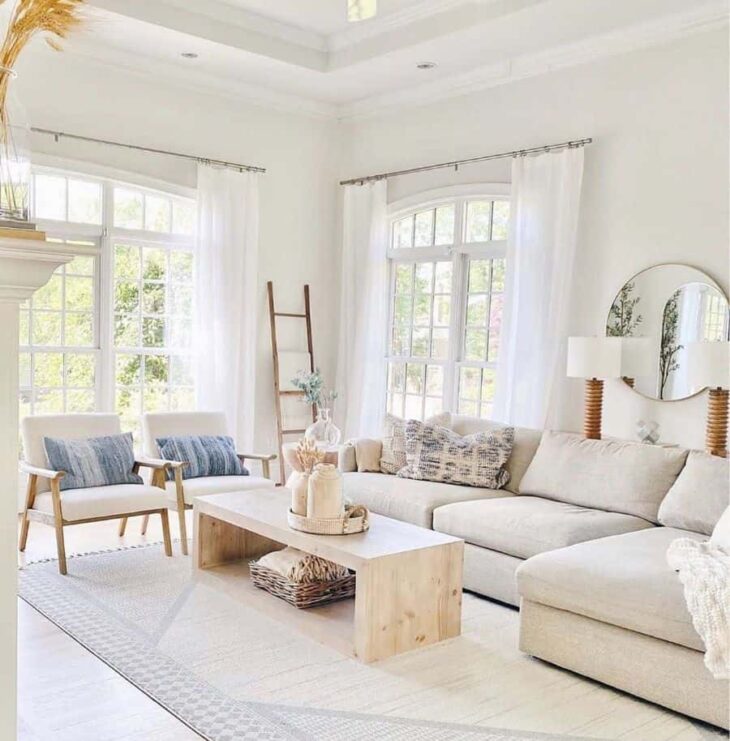
Source: nextluxury.com
The most important aspect to remember when it comes to lighting your living room is to combine different layers of lighting. A combination of different lights creates visual interest and is also recommended for functionality purposes.
A living room with plenty of natural lighting also needs extra light. Pendants and chandeliers are perfect lighting fixtures for living rooms that get plenty of natural light.
Overhead fixtures such as chandeliers are also ideal for rooms with high ceilings. When choosing an overhead light fixture, ensure it’s about a half or two-thirds of your living room’s table width.
If you’re living in a rented apartment, adding a wall or overhead lighting may be impossible. However, you can still add some glow to your living room by adding lampshades, table or floor lamps, and other lighting accessories.
6. The Size of the Coffee Table
When choosing your coffee table, ensure it’s at least half the length of your couch. This makes the two pieces look well put together.
Another rule to remember is that the coffee table shouldn’t be more than 2” shorter than the top of your couch cushions. Also, when arranging your furniture, allow at least 18 inches (45 cm) between your coffee table and your seating.
Further, if you’re adding a side table to your living room, make sure its top aligns to the height of your sofa’s arm.
7. Choose a Color Scheme
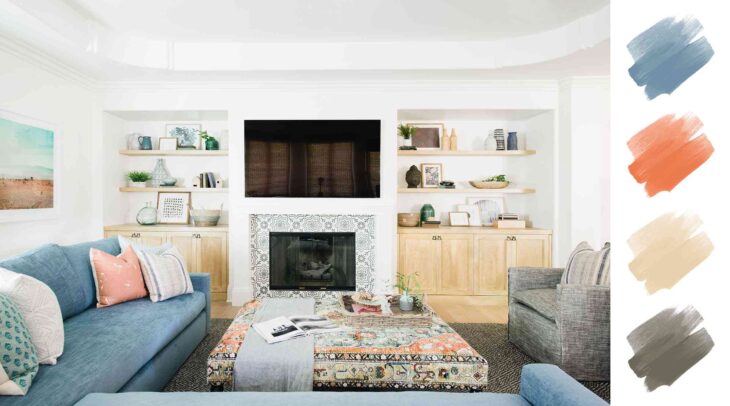
Source: mydomaine.com
While choosing a neutral color for your living room might seem like the safe thing to do, there are many benefits of adding some bright colors to your space. For starters, a bright color can turn a dull living room into a stylish space.
Besides, a small living room can appear larger when the walls are painted with a lighter shade. You can also use color to unite the different furnishings and accessories in your living room.
The easiest way to choose a good color for your living room is to get inspiration from the hue of a large piece of décor or accessory in your living room. Items like a large décor, a colorful area rug, or striking upholstery can give you color ideas that you can use for your living room. Using a color wheel is another great idea for choosing a color scheme for your living room.
If you choose to use different colors in your living space, follow the rule of 60-30-10. The rule recommends using 60% of the dominant color on the wall, 30% of the secondary color on the upholstery, and 30% of the accent color on the accessories.
8. Furniture Layout
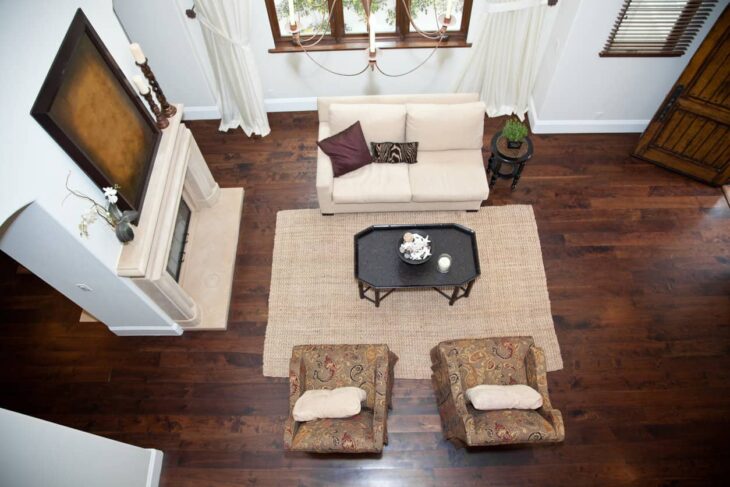
Source: homestratosphere.com
You should arrange your furniture around your room’s focal point.
Another essential furniture layout principle to follow is to pull the furniture away from the walls. This gives your pieces some breathing room and also makes a tiny living room appear bigger.
The size of your living room will determine how much space you leave between your sofa and the walls. However, the general rule of thumb is to leave at least 3” to 5” between the two.
Additionally, arrange your furniture in such a way that there is enough space for traffic flow. There should be at least 3.5” between seating and enough space between the coffee table and the couches to allow people to walk comfortably in the room without tripping on chairs or other furniture.
You should also arrange your furniture in a way that creates intimate conversation areas. For instance, position the sofas to face each other and ensure they’re close enough to encourage conversation. In the case of a large living room, you can create more than one conversation area.
In closing, styling your living room shouldn’t be stressful. Hopefully, our eight living room interior design rules will make the process of styling your space less frustrating.
